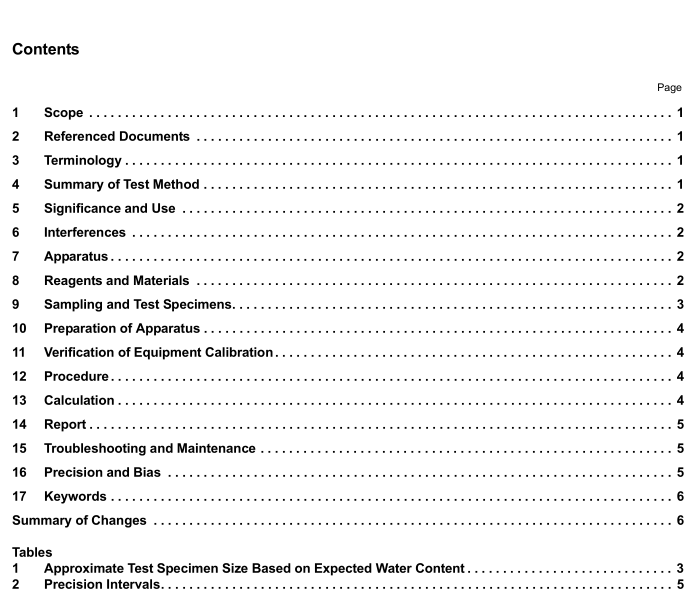API MPMS 10.9 pdf download

API MPMS 10.9 pdf download Manual of Petroleum Measurement Standards Chapter 10.9 Standard Test Method for Water in Crude Oils by Coulometric Karl Fischer Titration
4.2 The precision of this test method is critically dependent on the effectiveness of the homogenization step. The accept- ability of the mixing used to achieve a homogeneous sample is determined by the procedure given in Practice D5854 (API MPMS Chapter 8.3). In addition, if the test method is per- formed on a volume basis, the precision of the test method is critically dependent on the accuracy and repeatability of the volume injected.
4.3 Two procedures are provided for the determination of water in crude oils. In one procedure, a weighed test specimen is injected into the titration cell and the mass % of water is determined. The other procedure provides for the direct deter- mination of the volume % of water in the crude oil by measuring the volume of crude oil injected into the titration cell.
5. Significance and Use 5.1 The accurate analysis of a crude oil sample to determine the water content is important in the refining, purchase, sale, or transfer of crude oils. 6. Interferences
6.1 A number of substances and classes of compounds associated with condensation or oxidation-reduction reactions interfere in the determination ofwater by Karl Fischer. In crude oils, the most common interferences are mercaptans and sulfides (not total sulfur). At levels of less than 500 µg/g [ppm(m)] (as sulfur), the interference from these compounds is insignificant. Most crude oils, including crude oils classified as “sour crude,” have mercaptan and sulfide levels of less than 500 µg/g [ppm(m)] as sulfur. For more information on sub- stances that interfere in the determination of water by Karl Fischer titration method, see Test Method E203.
6.2 The significance of the mercaptan and sulfide interfer- ence on the Karl Fischer titration for water levels in the 0.005 to 0.02 mass % range has not been determined experimentally. At these low water levels, however, the interference may be significant for mercaptan and sulfide levels of less than 500 µg/g [ppm(m)] (as sulfur).
7. Apparatus 7.1 Karl Fischer Apparatus, using electrometric endpoint detector. The instrument must have anode and cathode reagents in separate compartments. Instructions for operation of Karl Fischer titration devices are provided by the manufacturer and not described herein.
7.2 Mixer, to homogenize the crude sample.
7.2.1 Non-Aerating, High-Speed, Shear Mixer—The mixer shall be capable of meeting the homogenization efficiency test described in Practice D5854 (API MPMS Chapter 8.3). The sample size is limited to that suggested by the manufacturer’s specifications for the size of the mixer.
7.2.2 Circulating Sample Mixer—A device such as used with automatic crude oil sampling receivers, is acceptable providing it complies with the principles of Practice D5854 (API MPMS Chapter 8.3).
7.3 Syringes—Test specimens are most easily added to the titration cell by means ofaccurate glass syringes with Luer Lok fittings and hypodermic needles of suitable length. The bores of the needles used should be kept as small as possible but large enough to avoid problems arising from back pressure and blocking while injecting a test specimen. The syringe size should be selected such that the test specimen is not less than half the total volume contained by the syringe, the needle should be long enough to permit the injection of the test specimen into the fluid, below the surface of the fluid in the titration cell.
7.3.1 Syringes for Gravimetric Determination—For gravi- metric determination, any type of syringe that does not leak is appropriate. Syringe should have physical dimensions to fit on the balance appropriately.
7.3.2 Syringe for Volumetric Determination—For volumet- ric determination a certified syringe capable of delivering the volumetric quantity with an accuracy 0.5% of the contained volume is required.
7.4 Balance for Mass Determination—Any analytical bal- ance with an accuracy and resolution of0.1 mg, and capable of weighing up to 100 g can be used.
7.4.1 The balance for determining the weight of the test specimen injected into the titration cell shall be calibrated. N OTE 1—The use of balances on structures that are in motion may not be appropriate.
7.5 Titration Cell—Sunlight can cause disassociation of the iodine in the Karl Fischer reagent, resulting in false results. A titration cell made of opaque material may reduce this effect.
8. Reagents and Materials 8.1 Purity of Reagents—Chemicals of reagent grade or higher purity shall be used in all tests. Unless otherwise indicated, it is intended that all reagents shall conform to the specifications of the Committee on Analytical Reagents of the American Chemical Society, where such specifications are available. 4 Other grades may be used, provided it is first ascertained that the reagent is of sufficiently high purity to permit its use without lessening the accuracy of the determi- nation.









